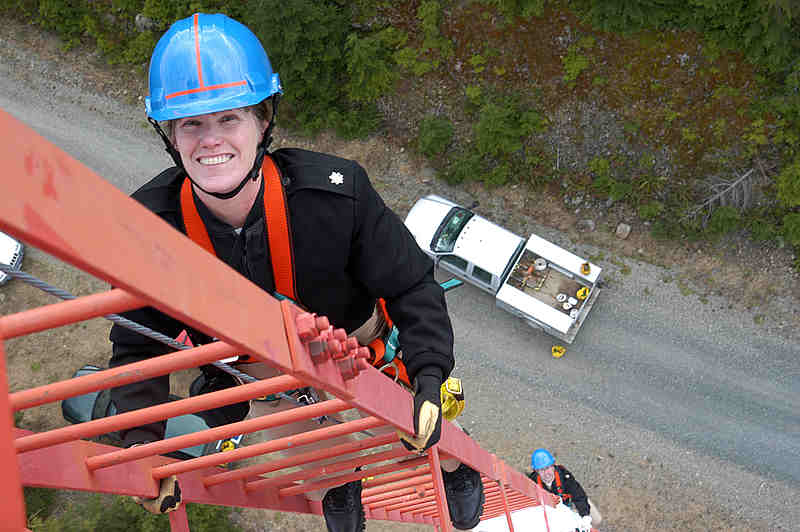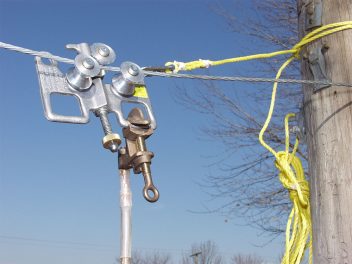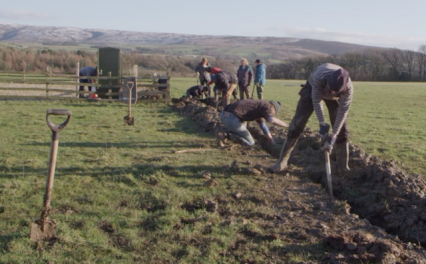According to OSHA, the Occupational Safety and Health Administration, the rate at which telecom workers die on the job is 10 times higher than construction workers.
For telecom workers maintaining on the job safety is difficult because technicians must not only be familiar with general construction safety guidelines, but also be aware of electrical safety and special rules that apply per OSHA and employer guidelines. Because of the many factors involved in safety for telecom workers, this post will only highlight a few of the most important.
Physical Conditioning
Many on the job tasks, especially within aerial jobs, force workers to raise one or both arms above the head. Looking up can put a considerable strain on your body and lead to “tendinitis, rotator cuff tears, arthritis, sprains, bursitis, and tension neck syndrome”. Injury is even more at risk when working with heavy materials or in awkward positions. Often in the industry, overhead work is unavoidable therefore it is of the upmost importance to proceed cautiously and be wary of injuring yourself. Increase efficiency by using tools that bring workers physically closer to their task, and try to limit the amount of tasks that require overhead work by better arranging work situations.
Safety Plan and Job Briefing
In order to maintain safety on the job use two key channels: a corporate safety plan, and a job-site safety checklist now required by OSHA as a Job Briefing.
A number of states have enacted their own safety legislation, and in most cases corporate safety plans must now be filed with the state. However, whenever you’re working on the job it is important to always keep safety top-of-mind and be aware of your surroundings.
Working Near Energized Equipment
Working on or near energized equipment can be dangerous, therefore it is always important to know the location of power supply.
In regard to work performed near power, the understanding of definition is required to maintain the difference between Power technicians as:
- “Qualified” to work near Power
and
- “Not Qualified” to work near power Telecom or cable technicians.
Remember, definitions are driven and ruled by regulations.
The definition for “Qualified Person” is found in OSHA 29 CFR Part 1910, Subpart S Electrical. Specifically, 1910.399 and defines a Qualified Person as:
“One who has received training in and has demonstrated skills and knowledge in the construction and operation of electric equipment and installations and the hazards involved.”
Two additional notes provide further clarification of the definition.
NFPA 70E®, “Standard for Electrical Safety in the Workplace®” defines “Qualified” person as:
“One who has skills and knowledge related to the construction and operation of the electrical equipment and installations and has received safety training to recognize and avoid the hazards involved.”
The definition for “Qualified” Person can also be found in Article 100 of the National Electrical Code® (NEC®). The term “Qualified Worker” as in “Qualified Electrical Worker Course” is often used to describe a “Qualified Person.”
- All Telecom and cable technicians are classified as “Not Qualified” to work near power and must recognize the safety zone maintained in the MAD, or Minimum Approach Distances rules.
Qualified persons must maintain awareness of switches, especially when handling circuits with dangerous voltages. Similarly, always ensure powered circuits are adequately insulated and never operate a switch with the other hand on a metal surface. It is also important to ensure de-energization. Verify that equipment has been de-energized before you touch a conductor. Double check that equipment or circuits are de-energized by using a voltmeter or voltage tester. Lastly, ensure that the installation is not powered by an additional power supply or protected via an additional fuse.
Fall Safety / Aerial Lifts
Aerial lift operation work is of a paramount concern, as there is a risk of falling or being electrocuted.
Lift operators must be trained and certified. When using bucket-trucks, injuries often happen when the wrong lift is selected for the job. Bucket-trucks are designated for a specific purpose:
Light-duty, medium-duty support, and heavy-duty construction applications.
Stationary work, like cable splicing, should be reserved for light-duty trucks, whereas medium-duty trucks should be used for plant support maintenance work. Similarly, medium and heavy machines are designed and built for specific operations.
Moving a truck with a person in the bucket or for cable or strand applications are only permitted with specialized equipment. Additionally, whenever you’re working in a bucket you should ensure that you’re wearing a safety lanyard, your unit is equipped with a working intercom system, and your machine is properly suited to the task. Also be sure to avoid the common mistakes of stringing cable with defective equipment or through a defective fairlead, or using an aerial lift truck to preform derrick functions.
Handling Fiber Optic Cables
When working with fiber optic cable, it’s important to be aware of safety issues related to eye protection, fiber fragment control, and safe use of chemicals. When handling cables, always wear safety gloves and safety goggles. The small pieces of glass that make up the fiber are so minuscule that they can easily penetrate the skin or be ingested. For these reasons when trimming, stripping, or cutting fibers, do not eat or drink in the fiber optic work area, and similarly work on a dark mat that is chemical resistant so it is easier to see small fragments that may have fallen. Likewise, unless a worker is sure there is not a light source at the other end, never look directly into the end of the cable as the blinding light can cause loss of visual acuity or blind spots. When pulling fiber optic cable, be careful not to get clothing caught in the machinery. Lastly, never stand opposite pulling lines or cables under tension as the whiplash could cause serious injury.
This blog is meant as a reminder to remain cognizant of your localized safety standards, and is not meant to be an exhaustive list. Please check with your safety person and follow company standards. Regardless, as a telecom worker safety should be your number one priority! For more information on safety from OSHA click here.
General Machine products have been supplying the telecom industry with American made tools since 1936. Call us today to at 215-357-5500 to see if your tools are up to industry safety standards.
(photo courtesy of http://www.atlantictraining.com/blog/telecom-technician-safety-training/)





